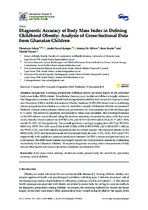| dc.description.abstract | Screening methods for childhood obesity are based largely on the published body mass index (BMI) criteria. Nonetheless, their accuracy in African children is largely unknown. The diagnostic accuracies of the World Health Organization (WHO), the Centers for Disease Control and Prevention (CDC), and the International Obesity Taskforce (IOTF) BMI-based criteria in defining obesity using deuterium dilution as a criterion method in a sample of Ghanaian children are presented. Methods: Data on anthropometric indices and percent body fat were collected from 183 children aged 8–11 years. The sensitivity, specificity, and predictive values were calculated. The overall performance of the BMI criteria was evaluated using the receiver operating characteristics area under the curve (AUC). Results: Overall sensitivity of WHO, CDC, and IOTF were 59.4% (40.6–76.3), 53.1% (34.7–70.9), and 46.9% (29.1–65.3) respectively. The overall specificity was high, ranging from 98.7% by WHO to 100.0% by IOTF. The AUC were 0.936 (0.865–1.000), 0.924 (0.852–0.995), and 0.945 (0.879–1.000) by the WHO, CDC, and IOTF criteria respectively for the overall sample. Prevalence of obesity by the WHO, CDC, IOTF, and deuterium oxide-derived percent body fat were 11.5%, 10.4%, 8.2%, and 17.5% respectively, with significant positive correlations between the BMI z-scores and percent body fat. Conclusions: The BMI-based criteria were largely specific but with moderate sensitivity in detecting excess body fat in Ghanaian children. | en_US |

